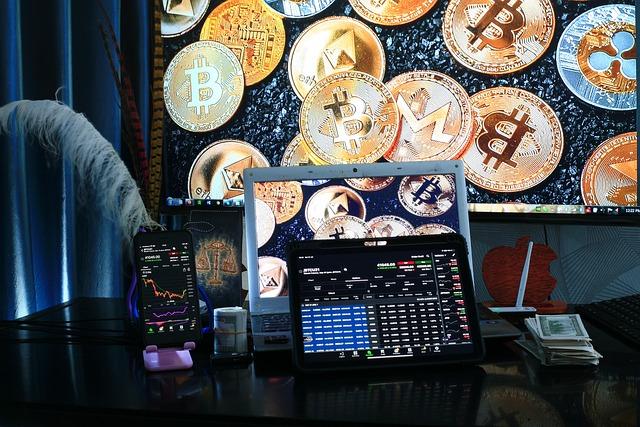Ready to up your trading game without diving into complex charts or mind-boggling jargon? Whether you’re just starting out or looking to sharpen your skills, making smarter moves in the trading world doesn’t have to be rocket science.In this post, we’re breaking down some top trading tips—simple, practical advice that anyone can follow to trade smarter, not harder. Let’s jump in and turn those trading jitters into confident, savvy moves!
Understanding Market Trends Like a Pro
When diving into the world of trading, grasping how markets shift and evolve is a game-changer. Successful traders don’t just guess—they analyze data and spot patterns before making moves.By paying attention to price action, volume changes, and external events like economic reports or industry news, you can get ahead of the pack. Remember, markets often move in cycles, so recognizing whether you’re in a bullish surge or a bearish dip helps you decide when to jump in or pull out.
To keep your strategy sharp, focus on a few key indicators that matter most for your style. Here are some essentials to keep on your radar:
- Moving Averages: Smooth out price data to identify longer-term trends vs. short-term noise.
- relative Strength Index (RSI): Measures overbought or oversold conditions.
- Volume Trends: Confirm price moves by the strength of trading activity.
| Trend Phase | Signs to Watch For | Recommended Action |
|---|---|---|
| Accumulation | Flat price,volume spikes | Prepare to buy |
| Markup | Rising price,high volume | Enter/hold long positions |
| distribution | price peaks,volume decline | Consider selling |
| Markdown | Falling price,high volume | Stay cautious |
Mastering the Art of Risk Management
Risk management isn’t just about avoiding losses — it’s about controlling them smartly to keep you in the game longer.One essential strategy is setting stop-loss orders to automatically exit a trade at a predetermined price. This isn’t just a safety net; it’s your personal trading guardrail that stops small mistakes from turning into big disasters. Another critical tip is to never risk more than a small percentage of your capital on a single trade — usually between 1% and 3%. Think of it like a poker game: you can’t win if you bet your entire stack on every hand.
Keeping a sharp eye on trade size and diversification also plays a pivotal role in smart risk management. Don’t put all your eggs in one basket — spread your investments across different assets to balance potential gains and setbacks. Here’s a simple breakdown of risk levels to help you decide how to allocate your trades:
| Risk Level | Recommended % of Capital | Ideal Trade Type |
|---|---|---|
| Low | 1% | Stable blue-chip stocks, bonds |
| Moderate | 2% | Index funds, diversified ETFs |
| High | 3% | Volatile commodities, cryptocurrencies |
- Review trades regularly—adjust stop-losses and positions as the market changes.
- Control emotions—fear and greed can inflate risks if not kept in check.
- Use risk/reward ratios—aim for trades where potential reward outweighs risk by at least 2:1.

Picking the Right Tools for the Job
Choosing the right tools is like having a secret weapon in the trading arena. It’s not about grabbing every shiny app or plugin; it’s about finding what fits your style and strategy perfectly. Start by focusing on user-pleasant platforms, real-time datafeeds, and customizable dashboards that make tracking your trades a breeze. Remember, simplicity wins over complexity—too many tools can cause analysis paralysis and lead to missed opportunities.
Before you dive headfirst, consider the essentials that will truly level up your game:
- Charting software: Visualize trends and spot patterns effortlessly.
- News aggregators: Stay ahead of market-moving events wiht instant updates.
- Risk Management Tools: Protect your capital with stop-loss and alert systems.
| Tool Type | Key Benefit | Example |
|---|---|---|
| Charting | Easy pattern recognition | TradingView |
| News | Real-time market updates | Bloomberg |
| Risk Management | Automatic alerts & protection | Stop-Loss Orders |
Staying Cool When the Market gets Wild
When markets start bouncing around like a roller coaster, it’s easy to get caught in the whirlwind of emotions. The key to navigating this chaos is to stay grounded and avoid making snap decisions based on fear or hype.Instead, rely on a clear plan that outlines your entry and exit points beforehand. Discipline becomes your best friend here—trust the strategy you’ve created, and resist the urge to chase every sudden move or news headline.
Keeping a cool head also means acknowledging that volatility is part of the game.To help manage this, try breaking down your trading day into simple chunks:
- Observe: Spend some time monitoring market trends without placing trades.
- Analyze: Use charts and fundamental data to back your decisions.
- Act: Execute trades only when your predetermined conditions align.
Visual aids can keep you calm and focused, so track your performance with a straightforward journal or a simple table like this:
| Day | Emotion Level | Trades Placed | Result |
|---|---|---|---|
| Monday | Medium | 3 | +2% |
| Tuesday | High | 5 | -1% |
| Wednesday | Low | 2 | +1.5% |
Learning from every Trade to Level Up
Every trade, whether it closes in profit or loss, carries a lesson that’s too valuable to ignore. By treating each transaction as a learning opportunity, you sharpen your instincts and refine your strategy over time. Keep a trading journal where you note down what went right,what went wrong,and how emotions influenced your decisions. This habit turns emotional reactions into objective insights, ensuring that mistakes aren’t repeated and successes are replicated with precision.
Here are a few quick ways to capitalize on every trade:
- Analyze your entries and exits to spot patterns in your timing.
- Review market conditions that affected the trade, identifying what worked and what didn’t.
- Adjust your risk management if losses reveal exposure beyond your comfort zone.
- Celebrate small wins – momentum boosts confidence for the next move.
| Trade Aspect | Key Question | Action |
|---|---|---|
| Entry Point | Was the timing optimal? | Adjust based on signals missed/spotted |
| Risk Level | Did I stick to my limits? | Recalibrate risk tolerance |
| Emotional Control | Did feelings cloud judgment? | Practice mindfulness or breaks |
Q&A
Q&A: Top Trading Tips – Simple Advice for Smarter Moves
Q: I’m new to trading. What’s the very first thing I should focus on?
A: Great question! Start by learning the basics inside and out—know the markets you want to trade, understand key terms, and get cozy with how trades work.Think of it like learning to ride a bike; you want to master balance before speeding off downhill.
Q: how important is having a trading plan?
A: super important! A solid trading plan is like your roadmap. It helps you set clear goals, manage risks, and stick to strategies without getting swayed by emotions. Make sure yours includes entry and exit points, risk tolerance, and your overall objectives.
Q: Should I focus on quick wins or long-term gains?
A: Both have their place, but unless you’ve got a lot of time and nerves of steel, long-term trading usually works better for beginners. Quick wins can be tempting but frequently enough come with higher risks. Patience really pays off in the trading game.
Q: How do I manage risk so I don’t lose it all?
A: Risk management is your BFF. Use stop-loss orders to automatically exit bad trades, never risk more than a small portion of your capital on one trade (think 1-2%), and diversify your trades so one loss doesn’t wreck your whole portfolio.
Q: What’s the biggest mistake newbie traders make?
A: Overtrading and chasing losses. It’s easy to get caught up trying to recover a bad trade fast, but that usually leads to bigger losses.Stick to your plan, take breaks if you’re stressed, and remember: trading is a marathon, not a sprint.
Q: How do I keep emotions from messing up my trades?
A: Emotions are tough to control,but the key is discipline and preparation. Follow your trading plan strictly, keep a trading journal to track your decisions and feelings, and don’t trade on impulse or “gut feelings.” The market doesn’t care about your mood!
Q: Any tools or resources you recommend?
A: Absolutely! Use demo accounts to practice without risking money, follow trusted financial news to stay updated, and check out trading platforms with good charts and analytics. Also, communities like trading forums or social media groups can be helpful if you stay critical and don’t follow tips blindly.
Q: What’s one final tip for smarter trading?
A: Keep learning. The market changes, and so should you. Read books, watch videos, analyze your trades, and be open to adapting your strategies. Trading smarter means evolving smarter.
Got more questions? Drop them in the comments—trading is tough but way more fun when you don’t go it alone!
The Way Forward
And there you have it—some straightforward trading tips to help you make smarter moves without overcomplicating things. Remember, trading isn’t about luck; it’s about having a plan, sticking to it, and learning along the way. Keep it simple, stay patient, and don’t be afraid to adjust as you go.Whether you’re just starting out or looking to sharpen your strategy, these tips are your little toolkit for smarter trading days ahead. Happy trading!











